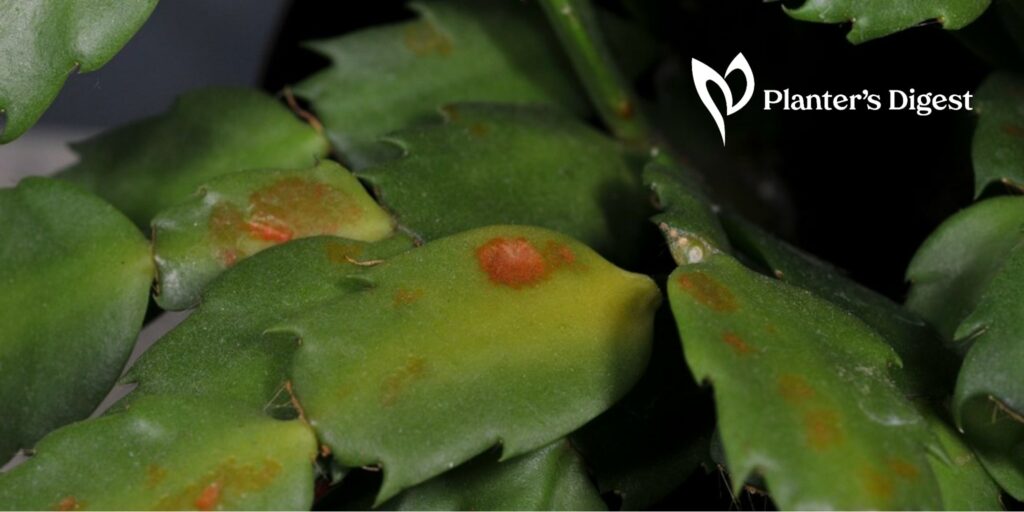Orange rusty spots on cacti are what acne is to our skin – unattractive and need to be treated! But how did those rust spots get there and what can we do about them?
While treatment can be varied, understanding the causes matters too. Let’s learn all we can so this doesn’t happen to our prickly plant in the first place!
Why does a cactus have rust or orange spots?
Rusty, orangey, or brown spots on your cactus are typically caused by changes in physiological processes. One of them is environmental, including light, humidity, temperature, frost, and poor air circulation.
Another is mismanagement, which includes overwatering and overfertilization. Finally, there are biotic factors such as pests and fungal diseases.
Rust Spots on Cactus: Causes and Fixes
When there are orange or rust spots on your cactus, you can easily treat them once you know the causes. We’ve made things simpler for you by first identifying the cause and then providing you with a quick how-to on treating it.
Fungal or Bacterial Infections
How to Fix:
Ensure proper soil drainage and moisture control.
Diseases cause orange or rust spots on your cactus due to excessive moisture, high humidity, or poor soil. This is because prolonged wet conditions encourage pathogens to thrive in the soil, working their way into the plant itself.
Fungal infections typically show up as slimy or powdery spots. On the other hand, bacterial infections produce lesions with a reddish or rusty color.
Ensure proper soil drainage and moisture control.
| Factor | Information |
| Difficulty | Moderate ●●○○○ |
| Speed | Gradual (weeks to months) |
| Materials Needed | Gravel, sand, perlite, fungicide, bactericide, clean sharp tools |
Cacti prefer well-draining soil, so make sure that they’re planted in a mix that has gravel, sand, or perlite with a bit of potting mix. There are also potting soil mixes specially made for cacti, so grabbing one would be a wise move.
To make sure there are minimal pathogens lurking in the soil, allow it to dry out between watering. You can also treat it with a suitable fungicide or bactericide – just follow the product instructions to make sure you’re doing it safely.
Take off infected areas using clean sharp tools and make sure to disinfect between cuts to avoid spreading the pathogens even further. Once you’ve done this, monitor moisture, humidity, airflow, and watering to your specific cactus needs.
Root Rot
How to Fix:
Improve soil drainage to prevent root rot.
Root rot is another moisture-related issue that can cause orange or rusty spots to show up on cacti. Cacti are not used to overly wet soil, and when exposed to this condition, their roots can get overwhelmed by the moisture and begin to rot.
Most of the time, this is caused by soil that doesn’t drain as quickly as it should. Overwatering is another cause while growing the cactus in a container with less than suitable drainage holes makes the situation even worse.
Solution: Improve soil drainage to prevent root rot.
| Factor | Information |
| Difficulty | Moderate ●●○○○ |
| Speed | Gradual (weeks to months) |
| Materials Needed | Gravel, sand, perlite, cactus soil mix, container with adequate drainage holes |
It all boils down to the soil you use to grow your cactus as well as the container that houses both soil and plant. First, you need to make sure that the soil is loose enough to allow water to drain quickly.
There are soil mixes for cacti, but you can always make your own by combining potting soil with some gravel, sand, and perlite. Once your soil is ready, transplant the cactus into the new soil.
Water your transplanted cactus sparingly and allow the soil to dry out a bit between watering. Check your plant for signs of recovery and adjust your watering as needed to keep the soil from becoming overly damp.
Physical Damage
How to Fix:
Treat the wounds right away and minimize further physical damage.
While prickly, cacti are susceptible to damage and wounds caused by rough handling, pruning, and even by curious or hungry animals. When damaged, the sensitive flesh of the cactus can become entry points for deadly pathogens.
These pathogens then take advantage of the cactus’ weakened state and attack it, causing localized discoloration similar to rust or orange spots.
Solution: Treat the wounds right away and minimize further physical damage.
| Factor | Information |
| Difficulty | Low to Moderate ●●○○○ |
| Speed | Variable (days to weeks) |
| Materials Needed | Clean, sharp scissors or pruning shears, antifungal solution (optional) |
If you see any wounds, trim the damaged part right away. Make sure to use clean and sharp scissors or pruning shears to avoid further damage as well as prevent possible contamination.
As an added precaution, you can apply an antifungal solution just to keep any infection out of the wound. Place the cactus in an area where it can remain undisturbed but still able to get its daily sunlight needs.
If the damage is pretty extensive, keep the cactus in a more controlled environment. During this time, provide the usual cactus care until it fully recovers from physical damage.
Pests
How to Fix:
Use insecticidal soap to control pests on cacti.
Pests such as scale insects or mites can infest cacti by feeding on their succulent flesh and causing damage. If your cactus has been previously stressed, the weakened state makes it even easier for pests to infest and populate quickly.
When they gather and feed, the pests can often leave discolored spots on the cactus flesh. Some may come out brown while others can be in rust or orange shades.
Solution: Use insecticidal soap to control pests on cacti.
| Factor | Information |
| Difficulty | Low to Moderate ●●○○○ |
| Speed | Relatively Fast (days to weeks) |
| Materials Needed | Insecticidal soap, spray bottle |
If you notice the orange or rust spots on your cactus are caused by troublesome critters, then bring out the big guns. Get some insecticidal soap and mix as directed on the label instructions.
Spray the solution on the affected areas and make sure to cover the area thoroughly. Repeat as needed or as directed on the label.
On top of that, isolate your infested cactus to prevent the pests from spreading to other plants. Regularly check your cactus to check for any remaining pests and treat them until everything is under control.
Sunburn
How to Fix:
Provide shade or gradually acclimate the cactus to direct sunlight.
Believe it or not, cacti can also experience sunburn even if they’ve adapted to intense sunlight. Usually, sunburn is caused when the cactus is suddenly exposed to extreme light conditions after being grown in a relatively darker spot.
Sunburn can lead to skin discoloration, usually showing up as rusty or orange spots on the affected areas.
Solution: Provide shade or gradually acclimate the cactus to direct sunlight.
| Factor | Information |
| Difficulty | Low to Moderate ●●○○○ |
| Speed | Gradual (weeks to months) |
| Materials Needed | Shade cloth, gradual increased exposure to sunlight |
When sunburn’s the suspect, protect your cactus right away from the intense light. You can move it to a less exposed spot, but this only works when your cactus is in a pot.
If your cactus is grown in the ground, use a shade cloth to protect it while slowly acclimatizing it to the higher level of sunlight exposure. Check regularly for signs of recovery, such as reduced discoloration of the orange or rusty spots.
Mineral Imbalance
How to Fix:
Ensure the cactus is receiving appropriate nutrients for its species.
Mineral imbalances are caused by an uneven distribution or deficiency of essential nutrients needed by the cactus for healthy growth. Cacti are particularly sensitive to variations in mineral content as they are adapted to living in nutrient-poor conditions.
Deficient or excess minerals can cause cacti to exhibit unusual growing conditions. Having rust or orange spots on its skin is one of the symptoms of mineral imbalance.
Solution: Ensure the cactus is receiving appropriate nutrients for its species.
| Factor | Information |
| Difficulty | Low to Moderate ●●○○○ |
| Speed | Gradual (weeks to months) |
| Materials Needed | Balanced cactus fertilizer, watering can |
Thankfully, this one’s a bit easier since all you need to do is provide a balanced cactus fertilizer. Look for one that’s specifically made for cacti and succulents.
Simply follow the recommended application dosages, rates, and timing. It’s better to have the fertilizer in diluted doses than in stronger concentrations to avoid excessive fertilization, which could damage the cactus.
Monitor and care for your cactus as usual, making sure to check for signs of recovery.
Disease Resistance
How to Fix:
Apply fungicide suitable for cacti or look for disease-resistant varieties in the future.
Some cactus species tend to be more susceptible to diseases or infections. Fungi like Diplodia and Phyllosticta concava don’t help either as they easily infect weak or susceptible cactus varieties by causing orange or rust spots on the plant.
Solution: Apply fungicide suitable for cacti or look for disease-resistant varieties in the future.
| Factor | Information |
| Difficulty | Low to Moderate ●●○○○ |
| Speed | Gradual (weeks to months) |
| Materials Needed | Fungicide for cacti, disease-resistant cactus variety |
If you suspect your cactus variety is more prone to diseases or infections, then you’ll need to use fungicides specially formulated for cacti. Follow the product instructions as carefully as possible to avoid stressing out the plant with incorrect applications.
Monitor the treated plant and repeat the treatment as needed. Make sure you provide the right care for the plant to avoid worsening the condition.
Meanwhile, you might want to grow cactus varieties that are more resistant to diseases, infections, or pests. Doing intensive research can help you make more sound decisions while ensuring your plants grow healthy without any issues.
Environmental Stress
How to Fix:
Provide stable environmental conditions and protect the cactus from extreme weather events.
Cacti can get stressed by fluctuating temperatures, abrupt changes in light conditions, and other environmental factors. Plus, if you live in an area where low temperatures cause frost or hail, your cactus can easily succumb to these conditions.
This stress can quickly show up as discolored spots on your cactus, typically in shades of orange, rust, brown, and even black.
Solution: Provide stable environmental conditions and protect the cactus from extreme weather events.
| Factor | Information |
| Difficulty | Low to Moderate ●●○○○ |
| Speed | Gradual (weeks to months, depending on conditions) |
| Materials Needed | Shade cloth, insulation (for frost protection) |
If your cactus is grown in an area that can be exposed to fluctuating or low temperatures with chances of hail, you need to keep it safe. Place it in a spot with stable temperatures and consistent lighting conditions.
When your cactus is planted on the ground, you can use shade cloth for that. Some homeowners use succulent polytunnels to insulate their cacti against unexpected frost, but you can also use burlap and other natural fiber as you wish.
Corking
How to Fix:
There is no direct solution for corking as it is a natural part of the cactus aging process.
Cactus corking is a natural process associated with the inevitable aging of the plant. This means that as the cactus matures, it goes through changes in its internal structure that lead to the formation of cork-like tissue on the exterior.
This is a natural response to the plant’s need for structural support as it continues to grow. The cork acts as a protective layer against damage and fluctuating temperatures.
Corking is the physical manifestation of aging, with rust or orange spots acting like age spots similar to human skin. While it may look worrisome, corking doesn’t harm the cactus but instead reflects the natural process of the plant’s life cycle.
Solution: There is no direct solution for corking as it is a natural part of the cactus aging process.
| Factor | Information |
| Difficulty | None (as it’s a natural process) |
| Speed | None (as it’s a natural process) |
| Materials Needed | None (as it’s a natural process) |
Since it’s just a natural part of plant aging, the best thing is to let the plant go through its life cycle. Continue to provide the right amount of care to your plant and monitor for potential issues, treating them quickly as soon as you can.
Can rust spots be prevented?
Rust spots can be prevented by implementing proactive measures such as using well-draining soil, regular inspections for pests and diseases, and providing proper ventilation and sunlight.
Additional approaches include watering and fertilizing properly as well as protecting the plant from extreme environmental conditions. Care should also be taken to ensure that the specific cactus variety is given the right amount of plant care.
How can rust spots affect the cactus?
Rust spots affect cacti by indicating the possible presence of pests and diseases. On top of that, rust spots cause cacti to become unsightly due to blemishes and discolorations on its skin.
Untreated rust spots can spread to other cacti or plants, causing extensive damage and weakening the plant’s structure. Eventually, the untreated plant may become compromised and unable to live.





